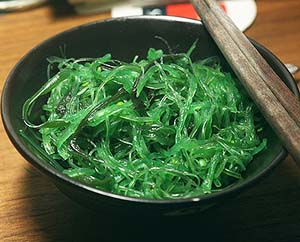Wakame seaweed Nutrition facts
Wakame seaweed is a strong-flavored, edible, algae popularly featured in Korean, Japanese, and Chinese cuisine. It is a kind of brown algae, similar to nori, and kombu but turns green once processed.
Scientific name: Undaria pinnatifida, Family: Alariaceae.
Like other Phaeophyceae class of marine seaweeds, wakame too composes pigment fucoxanthin, which is responsible for the distinctive greenish-brown hue.
 |
| Wakame salad (Photo courtesy: fujiwara.tw) |
Wakame grows in inter-tidal cold waters of Northern hemisphere oceans at a depth of 3-10 meters. The Republic of Korea and China are the chief commercial producers of this seaweed. Mature stage wakame features sporophyll consisting of the holdfast, strap-like midrib, and commercially important; fern-like leaf blades.
Cultivation
Like other Porphyra species, wakame is cultivated in seaweed farms where the shore emerges above seawater during low tides and submerges under the water at the time of high tides. The ropes are so arranged in the ocean that they are allowed to come out of the water and be exposed to the air for a few hours of the day. The Porphyra spores then germinate on the ropes and grow into a new thallus (blade).
After harvesting, wakame leaf blades are blanched in hot water for a few seconds, which are then mixed thoroughly with salt. The salted leaf blades are packed in bags and pressed with heavy objects overnight to remove the excess salt water. Thereafter, the midribs and blades are separated manually by hand, packed into boxes, and stored between -5 and -15° C.
Traditionally, fresh wakame seaweed is processed into simply suboshi wakame wherein the pieces are dried under the sun or in a hot air dryer. However, this product often fades by active enzymes during storage. To avoid this, its leaf blades are processed into haiboshi wakame wherein the fresh wakame is mixed with ash, spread on the ground for 2–3 days, then placed in a bag in the dark. High PH of ash inactivates fucoxanthin pigment producing (brown color) enzymes while retaining chlorophyll pigments in wakame stay brilliant-green for a long time.
Mekabu: It is the flowering sprout at the base of wakame. Fresh mekabu, available only in spring in the shops. It is added to salads or soups to enhance the slimy texture.
Health Benefits of Wakame seaweed
Wakame is a low-calorie and low-fat seafood. It holds just 45 calories in 100 grams, slightly more than that of nori (35 calories).
Wakame seaweed is rich in minerals, anti-oxidants, omega-3 fatty acids, protein, vitamins, and dietary fiber in ample amounts contributing to overall health and wellness.
It is composed of algae polysaccharides (alginic acid), pigments, and trace elements which may have anticancer properties. These compounds have been known to possess antiviral activities and work to help maintain cardiovascular health.
Wakame sporophyll contains a high content of bioactive sulfated polysaccharide, fucoidan. Fucoidan is believed to have antioxidant, and anti-viral properties, in addition to being effective in the prevention of some cancers.
Wakame products contain appreciable amounts of essential trace elements such as iodine, iron, copper, cobalt, selenium, nickel, and zinc, similar to nori and kombu.
Wakame is a very nutritious seaweed with easily digestible and bio-available protein and minerals. In traditional Japanese medicine, wakame is recognized as "food and medicine combined in one". Its daily consumption is believed to purify the blood.
Unlike nori, wakame seaweed consists of only a moderate amount of vitamin-A. 100 g of wakame contains 360 IU or 12 % of daily recommended levels of vitamin A . Vitamin A is essential for mucosal health and the integrity of cell membranes. It is also required by the special cells (rods) in the retina for night vision. Consumption of natural vegetables and fruits rich in vitamin A and flavonoids are also known to help the body protect from lung and oral cancers.
It is an excellent source of B-complex vitamins such as folates-49%, riboflavin-19%, niacin-10%, thiamin-5% of daily allowance (DA). Sufficient folates in the diet may help prevent neural tube defects in newborns.
Unlike in nori, wakame consists of very small amounts (5 mg or 8% of daily recommended levels) of vitamin C. This vitamin is a water-soluble antioxidant that helps in the boosting of immunity and equips the human body to combat infectious agents.
Just as in nori, wakame seaweed is also an important sea-vegetable source of EPA (0.186 g/100 g of 20:5 n-3, Eicosapantonoic acid), a omega-3 fatty acid.
| Principle | Nutrient Value | Percent of RDA |
|---|---|---|
| Energy | 45 Kcal | 2% |
| Carbohydrates | 9.14 g | 7% |
| Protein | 3.03 g | 5.41% |
| Total Fat | 0.64 g | 3% |
| Cholesterol | 0 mg | 0% |
| Dietary Fiber | 0.5 g | 1% |
| Vitamins | ||
| Folates | 196 μg | 49% |
| Niacin | 1.600 mg | 10% |
| Pyridoxine | 0.002 mg | <1% |
| Riboflavin | 0.230 mg | 19% |
| Thiamin | 0.060 mg | 5% |
| Vitamin-A | 360 IU | 12% |
| Vitamin-C | 3 mg | 5% |
| Vitamin-E | 1 mg | 7% |
| Vitamin-K | 5.3 μg | 4% | Electrolytes |
| Sodium | 872 mg | 58% |
| Potassium | 50 mg | 1% |
| Minerals | ||
| Calcium | 150 mg | 15% |
| Copper | 0.284 mg | 31.5% |
| Iron | 2.18 mg | 27% |
| Magnesium | 107 mg | 27% |
| Manganese | 1.400 mg | 61% |
| Phosphorus | 80 mg | 11% |
| Selenium | 0.7 μg | 1% |
| Zinc | 0.38 mg | 3.5% |
| Phyto-nutrients | ||
| Carotene-α | 0 μg | -- |
| Carotene-ß | 216 μg | -- |
| EPA (20:5 n-3) | 0.186 g | -- |
Selection and storage
In Korean seashore markets, one can buy fresh brown algae in the season. Oftentimes, it is the dried wakame that is sold in the grocery stores. If you choose fresh wakame, look for healthy-looking brown algae that are free from dirt and sand.
Ready-to-use, dehydrated, or dried wakame flakes in air-tight packs are available in the USA stores and supermarkets all around the year.
Most of the dehydrated products are of the traditional type, such as Su-boshi (dried under the sun without ash treatment) and Hai-boshi (ash treated) wakame. Haiboshi wakame can keep its brilliant green hue and nice fragrance which may last for a couple of months when stored in closed containers at room temperature.
Buy flake/powder in air-seal packs. Note for the authenticity and date of packing.
At home, store wakame in a cool, dry place away from moisture and humidity. Keep wakame flakes and powder in sealed containers.
Preparation and serving methods
Fresh and rehydrated wakame seaweeds are edible raw. To rehydrate, soak dry wakame flakes in hot water for 10-15 minutes till it soften, remove, and again dip in cold water. Squeeze to remove excess salt content. Slice as you desire it in recipes. It is often cooked ( for a few minutes).
It is used in soup, salad, and marinades. It works well with rice, pasta dishes, vegetables, tofu, meat, poultry, fish, and seafood.
Here are some serving ideas:
 |
| Wakame salad, edamame and miso soup Photo courtesy: Javier Lastras |
In South Korea, where it is called miyeoak (미역) or sea-mustard, wakame is one of the most popular seaweeds consumed. Traditionally, it is prepared in soups (miyeok-guk) to feed mothers soon after the birth of the baby.
Miyeok muchim (미역무침, wakame salad) is a delicious side dish in the Korean peninsula.
In Japan, rehydrated wakame is used liberally in the preparation of miso soup, and cucumber vinegar salad (sunomono).
Safety profile
Like other marine produce, wakame seaweed carries relatively higher concentrations of sodium and other minerals, trace elements, and heavy metals. Moderate consumption of wakame (not more than 10 grams per day) offers several health benefits such as omega-3 fatty acids, which otherwise are not found in many plant-based diets. (Medical disclaimer).
Read further on:
≺≺ Nori Seaweed Nutrition Facts.
≺≺ Spirulina: Superfood for Nutrition, Weight Loss, and Health Benefits.
≺≺ Back to Edible Seaweeds from Wakame seaweed. Visit here for an impressive list of seaweeds with complete illustrations of their nutrition facts and health benefits.
≺≺ Back to Home page.
Further reading (Links opens in new window):
Fisheries and Aquaculture Department-Undaria pinnatifida.
Cultured Aquatic Species Information Programme, Porphyra spp. PDF.